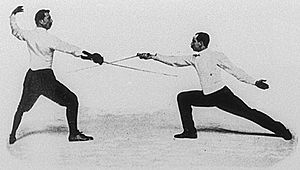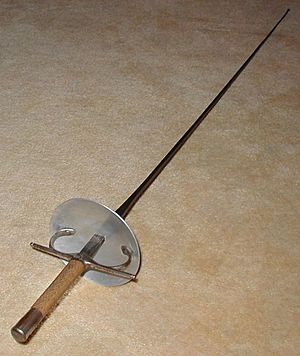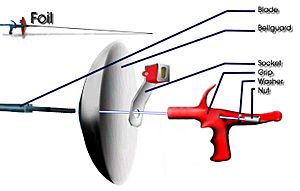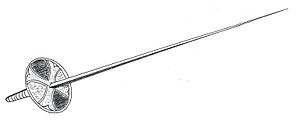Foil (fencing) facts for kids
A foil is one of the three main weapons used in the sport of fencing. It's a light, flexible metal sword, weighing less than half a kilogram (about one pound). Like the épée, you score points only by touching your opponent with the tip of the foil.
In modern fencing competitions, the tip has a special button. When it touches an opponent, it sends an electrical signal. Foil fencers wear a special vest called a lamé. This vest is wired to record hits on the valid target area. The foil is the most popular weapon used in fencing competitions.
Contents
Types of Foils

There are two main types of foils used today: electric and non-electric. Both types have the same basic parts: the pommel, grip, guard, and blade.
Non-electric foils are often called "steam" or "dry" foils. They are mostly used for practice. Electric foils have a button at the tip. This button helps score points automatically. With non-electric foils, a judge has to decide if a touch was made.
Most major fencing organizations, like the Fédération Internationale d'Escrime, have required electric scoring since the 1956 Olympics.
The Foil Blade
Foil blades are long and thin, shaped like a rectangle. They are made from strong, specially treated steel. The blade is designed to bend when it hits something. This helps prevent injuries to fencers.
- The longest a foil blade can be is 90 centimeters (about 35 inches).
- The entire weapon, when put together, can be up to 110 centimeters (about 43 inches) long.
- The maximum weight for a foil is 500 grams (about 1.1 pounds). However, most competition foils are lighter, around 350 grams.
The blade has two main parts:
- The forte is the strong part, closest to the guard.
- The foible is the weak part, closer to the tip.
A part of the blade called the tang goes inside the grip. It helps hold the whole foil together.
The Guard and Grip
The guard is a cup-shaped piece that protects the fencer's hand. It is attached to the blade and the grip. The pommel is a cap at the end of the grip that holds everything tightly together.
There are different types of grips:
- Straight traditional grips (like Italian or French grips) have an external pommel.
- Pistol grips are newer. They are shaped to fit the hand in a specific way. Their pommels fit inside the grip.
Electric Foils in Detail
Since the 1956 Olympics, electric scoring has been used in foil fencing. A small switch at the tip of the foil registers a touch. A metallic vest, called a lamé, makes sure the touch is on the correct target area.
How the Electric System Works
Electric foils have a socket under the guard. This socket connects to the scoring machine with a wire called a body cord. Another wire runs inside the blade to the tip.
The tip of an electric foil has a button system. It includes a barrel, a plunger, and a spring. When the tip is pressed, it breaks an electrical circuit. This causes the scoring machine to light up.
- A white or yellow light means the touch was off-target.
- A red or green light means the touch was on the valid target area. Each fencer has a different color.
History of the Foil
The modern foil comes from a training weapon used for the "small-sword." This was a common sword carried by gentlemen in the 1700s.
People have used blunted swords for practice since the 1500s. However, using the foil as a sport weapon is more recent. In France, in the mid-1700s, the foil became a training tool for fast and elegant thrusting. Fencers would blunt the tip by wrapping it or adding a knob. This knob was called a "blossom" (fleuret in French).
Sometimes, fencers would remove the protection and use sharp foils for duels. German students adopted this practice. They developed a special thrusting sword for their academic duels.
The target area in modern foil fencing comes from a time when fencing was practiced with limited safety gear. Also, the rules were based on dueling, where hitting vital organs was important. That's why the torso is the main target area.
Foil fencing became an Olympic sport in 1896 at the first Olympic Games in Athens.
Women's Foil Fencing
Women's foil was first included in the Olympics in 1924 in Paris. For a long time, it was the only fencing event for women. Women's épée was added in 1996. Today, women's fencing is very popular, and women compete in all three weapons: foil, épée, and sabre.
Fencer Ratings
Fencers get ratings to group them by skill level. This helps create fair competitions. You earn a higher rating by doing well in tournaments and beating fencers with higher ratings.
Ratings go from lowest to highest:
- U (unranked)
- E
- D
- C
- B
- A
The rating is followed by the year it was earned (e.g., A2017).
Age Groups in Fencing
Fencers are also divided into age groups. This helps match fencers with similar skill and physical development.
Common age groups for foil (and épée and sabre) include:
- Y10 (ages 10 and under)
- Y12 (ages 12 and under)
- Y14 (ages 14 and under)
- Cadet (ages 16 and under)
- Junior (ages 19 and under)
- Senior (ages 19 and over)
Older fencers cannot compete in younger categories. However, younger fencers are allowed and encouraged to compete in older categories to help them learn faster.
Other groups include:
- Div 1: For the best fencers.
- Div 1A: Just below Div 1.
- Div 2: For B-rated fencers and below.
- Div 3: Open to all lower-ranked fencers.
- Veteran: For fencers aged 40 and over, with sub-groups for 60 and over, and 70 and over.
Foil Fencing Rules
The rules for fencing are set by national sports groups, like the United States Fencing Association (USFA) in the U.S. Internationally, the rules are managed by the International Fencing Federation, or Fédération Internationale d'Escrime (FIE).
The detailed rules for foil fencing are in the USFA Rulebook. The current international rules for foil were first adopted in 1914. Rules for electric scoring were added in 1957 and have been updated since then.
How Scoring Works
The foil is a "thrusting" weapon. This means you can only score points by touching your opponent with the tip of the blade. Hitting with the side of the blade does not count.
To score a touch, the tip of the foil must be pressed down for at least 15 milliseconds. It must also be in contact with the opponent's lamé. The lamé is a special wired jacket that covers the valid target area. The foil tip must be able to withstand a force of at least 4.90 newtons (about 500 grams) without the circuit breaking.
Valid Target Area
In foil fencing, the valid target area includes:
- The torso (the main part of the body).
- The lower part of the mask's bib (the fabric under the chin).
- The groin area.
Touches made on the head (except the lower bib), arms, or legs do not count for points. However, an off-target touch will stop the action, and play will restart. The target area has changed a few times over the years. The most recent change added the bottom half of the mask's bib to the target zone.
Images for kids
See also
 In Spanish: Florete para niños
In Spanish: Florete para niños






